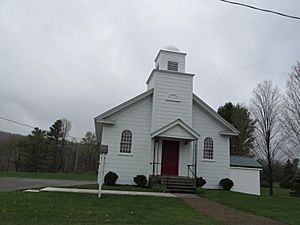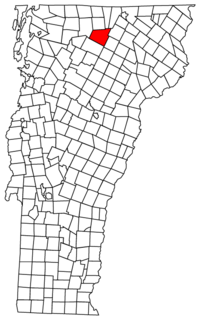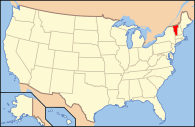Lowell, Vermont facts for kids
Quick facts for kids
Lowell, Vermont
|
|
|---|---|
|
Town
|
|
 |
|

Located in Orleans County, Vermont
|
|

Location of Vermont with the U.S.A.
|
|
| Country | United States |
| State | Vermont |
| County | Orleans |
| Chartered | February 7, 1791 |
| Communities | |
| Area | |
| • Total | 56.1 sq mi (145.2 km2) |
| • Land | 56.0 sq mi (145.1 km2) |
| • Water | 0.1 sq mi (0.1 km2) |
| Elevation | 996 ft (287 m) |
| Population
(2020)
|
|
| • Total | 887 |
| • Density | 16/sq mi (6.1/km2) |
| • Households | 365 |
| • Families | 238 |
| Time zone | UTC-5 (EST) |
| • Summer (DST) | UTC-4 (EDT) |
| ZIP code |
05847
|
| Area code(s) | 802 |
| FIPS code | 50-40525 |
| GNIS feature ID | 1462137 |
Lowell is a town located in Orleans County, Vermont, in the United States. It is the westernmost town in this county. In 2020, about 887 people lived there.
Contents
Lowell, Vermont: A Small Town's Story
Where is Lowell?
Lowell covers about 56.1 square miles (145.2 km2). Most of this area is land, with a small amount of water. The main village of Lowell is right in the middle of the town.
Amazing Rocks and Landforms
Around 400 million years ago, huge, slow movements of the Earth's crust created special rocks called serpentine rock. These rocks are found in places like Brown's Ledges, near the border with Westfield. A rare fern, called Adiantum viridimontanum, can grow here because it can handle the high nickel in serpentine. Serpentine also has iron, which means some of these rocks can even be magnetic! This iron gives Brown's Ledges its brownish color.
A major fault line (a crack in the Earth's crust) also runs through Lowell. One part of a river follows this fault, with serpentine rocks on one side and different rocks on the other.
A quarry (a place where rocks are dug out) on Belvidere Mountain used to mine a material called chrysotile (a type of asbestos). This quarry was the last asbestos mine to operate in the eastern United States, closing in 1993.
A Look Back: Lowell's History
Early Days and Settlers
Lowell was officially created, or chartered, on February 7, 1791. It was first named Kellyvale after John Kelley. The first non-Native American people to visit the area were surveyors in 1778. They were preparing for a military road to Canada, but this road was never finished.
The first families to settle in Lowell arrived in 1806. The town was formally organized in 1812, and the first school opened that same year with twelve students. People first noticed asbestos in the area in 1824. In 1831, the town's name was changed to Lowell, but no one is quite sure why.
Growing and Changing
Lowell grew from 144 people in 1820 to 413 people in 1840. By 1840, churches were built, and different religious services were held.
In the early 1800s, most new residents came from other U.S. states. Later, in the second half of the century, more people arrived from other countries, especially Ireland and French-speaking Canada. The town's population reached its highest point in 1890 with 1,178 people.
Farming and lumber were the main ways people made a living. Dairy products and hardwood were sent to other states. However, a large lumber mill closed in the 1920s, causing many people to leave. The population dropped by 40% between 1920 and 1940.
The Asbestos Mine Story
Asbestos mining became important in Lowell. In 1870, several tons of asbestos were mined. By 1910, Lowell produced half of all the asbestos mined in the United States. The asbestos mine on Belvidere Mountain was very important for the economy from the 1940s until the mid-1980s. In the mid-1940s, this mine produced over 90% of all U.S. asbestos. It finally closed in 1992.
In 2008, there was a concern about health risks for people living near the old asbestos mine. However, a study in 2009 found that health problems linked to the mine were mainly from people who worked there. The report said that people living nearby did not have a higher risk of asbestos-related sickness than others in Vermont. Still, the site needs to be cleaned up.
Powering Up with Wind
In 2012, a large wind farm called Kingdom Community Wind started operating in Lowell. It has 21 wind turbines that create enough electricity for over 24,000 homes in Vermont each year. This is the biggest wind farm in the state.
Who Lives in Lowell?
| Historical population | |||
|---|---|---|---|
| Census | Pop. | %± | |
| 1820 | 144 | — | |
| 1830 | 314 | 118.1% | |
| 1840 | 431 | 37.3% | |
| 1850 | 637 | 47.8% | |
| 1860 | 813 | 27.6% | |
| 1870 | 942 | 15.9% | |
| 1880 | 1,067 | 13.3% | |
| 1890 | 1,178 | 10.4% | |
| 1900 | 983 | −16.6% | |
| 1910 | 1,086 | 10.5% | |
| 1920 | 1,005 | −7.5% | |
| 1930 | 725 | −27.9% | |
| 1940 | 615 | −15.2% | |
| 1950 | 643 | 4.6% | |
| 1960 | 617 | −4.0% | |
| 1970 | 515 | −16.5% | |
| 1980 | 573 | 11.3% | |
| 1990 | 594 | 3.7% | |
| 2000 | 738 | 24.2% | |
| 2010 | 879 | 19.1% | |
| 2020 | 887 | 0.9% | |
| U.S. Decennial Census | |||
According to the 2000 census, Lowell had 738 people living there. Most residents were White. About 38.5% of households had children under 18. The average age of people in Lowell was 35 years old.
Since the 1980s, the number of people living in Lowell has grown. Many residents work in farming, while others travel to nearby towns for their jobs. Some people also work from home.
Famous Faces from Lowell
- Frederick W. Baldwin, a lawyer and politician who led the Vermont Senate.
- John C. Caldwell, a teacher, diplomat, and Civil War general.
- Donald Collins, a member of the Vermont Senate.
- Edgar S. Coolidge, a farmer and lawmaker.
See Also
 In Spanish: Lowell (Vermont) para niños
In Spanish: Lowell (Vermont) para niños

